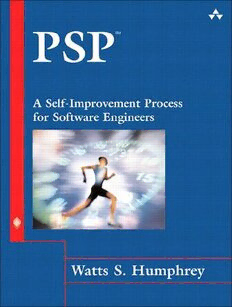
PSP(sm): A Self-Improvement Process for Software Engineers (SEI Series in Software Engineering) PDF
Preview PSP(sm): A Self-Improvement Process for Software Engineers (SEI Series in Software Engineering)
PSPSM This page intentionally left blank PSPSM A Self-Improvement Process for Software Engineers Watts S. Humphrey with Support Tool by James W. Over Upper Saddle River,NJ • Boston • Indianapolis • San Francisco New York • Toronto • Montreal • London • Munich • Paris • Madrid Capetown • Sydney • Tokyo • Singapore • Mexico City The SEI Series in Software Engineering Many of the designations used by manufacturers and sellers to distinguish their products are claimed as trademarks. Where those designations appear in this book,and the publisher was aware of a trade- mark claim,the designations have been printed with initial capital letters or in all capitals. CMM,CMMI,Capability Maturity Model,Capability Maturity Modeling,Carnegie Mellon,CERT, and CERT Coordination Center are registered in the U.S. Patent and Trademark Office by Carnegie Mellon University. ATAM; Architecture Tradeoff Analysis Method; CMM Integration; COTS Usage-Risk Evaluation; CURE; EPIC; Evolutionary Process for Integrating COTS Based Systems; Framework for Software Product Line Practice; IDEAL; Interim Profile; OAR; OCTAVE; Operationally Critical Threat,Asset, and Vulnerability Evaluation; Options Analysis for Reengineering; Personal Software Process; PLTP; Product Line Technical Probe; PSP; SCAMPI; SCAMPI Lead Appraiser; SCAMPI Lead Assessor; SCE; SEI; SEPG; Team Software Process; and TSP are service marks of Carnegie Mellon University. Special permission to reproduce “PSP process materials”(©2004 by Carnegie Mellon University) is granted by the Software Engineering Institute. The author and publisher have taken care in the preparation of this book,but make no expressed or im- plied warranty of any kind and assume no responsibility for errors or omissions. No liability is assumed for incidental or consequential damages in connection with or arising out of the use of the information or programs contained herein. The publisher offers excellent discounts on this book when ordered in quantity for bulk purchases or spe- cial sales,which may include electronic versions and/or custom covers and content particular to your business,training goals,marketing focus,and branding interests. For more information,please contact: U. S. Corporate and Government Sales (800) 382-3419 [email protected] For sales outside the U. S.,please contact: International Sales [email protected] Visit us on the Web:www.awprofessional.com Library of Congress Cataloging-in-Publication Data: Humphrey,Watts S.,1927– PSP :a self-improvement process for software engineers / Watts S. Humphrey. p. cm. — (The SEI series in software engineering) Includes bibliographical references and index. 1. Software engineering. 2. Computer software—Management. I. Title. II. Series. QA76.758.H8624 2005 005.1—dc22 2004030348 Copyright ©2005 Pearson Education,Inc. All rights reserved. Printed in the United States of America. This publication is protected by copyright, and permission must be obtained from the publisher prior to any prohibited reproduction,storage in a retrieval system,or transmission in any form or by any means,electronic,mechanical,photocopying, recording,or likewise. For information regarding permissions,write to: Pearson Education,Inc. Rights and Contracts Department One Lake Street Upper Saddle River,NJ 07458 ISBN 0-321-30549-3 Text printed in the United States on recycled paper at Courier in Westford,Massachusetts. First printing,March 2005 IN MEMORY OF DR. JOHN E. YARNELLE an inspiring teacher This page intentionally left blank CONTENTS PREFACE XIII Chapter 1 THE PERSONAL PROCESS STRATEGY 1 1.1 The PSP’s Purpose 3 1.2 The Logic for a Software Engineering Discipline 4 1.3 Using Disciplined Development Practices 6 1.4 Operational Processes 6 1.5 Defining and Using a Personal Process 7 1.6 Learning to Use a Personal Process 8 1.7 Preparing for the Team Software Process 9 1.8 Summary 9 Reference 10 Chapter 2 THE BASELINE PERSONAL PROCESS 11 2.1 What Is a Process? 12 2.2 Defining Your Own Process 13 2.3 Baseline Process Contents 14 2.4 Why Forms Are Helpful 16 2.5 The PSP Process Elements 17 2.6 The PSP0 Process 18 2.7 PSP0 Measures 20 2.8 Time Recording 21 vii viii Contents 2.9 Defect Recording 24 2.10 The PSP0 Project Plan Summary 30 2.11 The Compile Phase 31 2.12 Incremental Development 32 2.13 PSP Tool Support 34 2.14 Summary 34 2.15 Exercises 34 Chapter 3 MEASURING SOFTWARE SIZE 35 3.1 Size Measures 35 3.2 Establishing a Database Counting Standard 40 3.3 Establishing a Line-of-Code Counting Standard 40 3.4 Size Accounting 42 3.5 Using Size Data 45 3.6 Calculating Productivity 47 3.7 Size Counters 48 3.8 Other Size Measures 53 3.9 Summary 54 3.10 Exercises 54 References 55 Chapter 4 PLANNING 57 4.1 The Planning Process 58 4.2 Why Make Plans? 59 4.3 What Is a Plan? 60 4.4 The Contents of a Software Plan 60 4.5 Planning a Software Project 62 4.6 The Conceptual Design 63 4.7 Plan Quality 65 4.8 Planning Issues 65 4.9 Summary 66 Reference 67 Contents ix Chapter 5 SOFTWARE ESTIMATING 69 5.1 Size Estimating Principles 69 5.2 The Conceptual Design 70 5.3 Proxy-Based Estimating 71 5.4 Using Proxies in Estimating 75 5.5 Producing the Relative-Size Table 78 5.6 Estimating Considerations 80 5.7 Summary 84 Chapter 6 THE PROBE ESTIMATING METHOD 85 6.1 Estimating from Data 85 6.2 Proxy-Based Estimating 87 6.3 Estimating with Limited Data 95 6.4 An Estimating Example 100 6.5 Estimating Nonprogramming Tasks 102 6.6 Considerations in Using PROBE 105 6.7 Summary 108 6.8 Exercises 108 Chapter 7 SOFTWARE PLANNING 109 7.1 Plan Requirements 109 7.2 Project and Period Plans 111 7.3 Producing the Schedule 113 7.4 Making the Schedule 115 7.5 Earned Value 119 7.6 An Earned Value Example 120 7.7 Comments on the EV Example 123 7.8 Estimating Accuracy 125 7.9 The Prediction Interval 126 7.10 Alerting Management to Changes 128 7.11 Planning Considerations 129 7.12 Summary 131 7.13 Exercises 132 References 132
